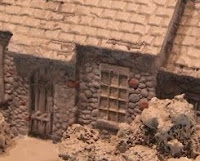 I have started painting my Thomas Kinkade cottage. As the instructions told me, the walls received a coat of pale grey and then some of the stones were picked out with dark grey and brown. Finally, after 24 hours a wash of dark grey was to unify the look and fill in the mortar lines.
I have started painting my Thomas Kinkade cottage. As the instructions told me, the walls received a coat of pale grey and then some of the stones were picked out with dark grey and brown. Finally, after 24 hours a wash of dark grey was to unify the look and fill in the mortar lines.Sadly, it looks rubbish. The photo doesn't do it justice, it's much worse than that.
The dark grey is hardly darker than the light version so the tonal difference between stones was tiny. The dark grey was hopeless as a mortar colour but adding some black darkened it up enough.
Worst of all though, the mortar wash removed the picked out stones. Acrylic always seems to do this when I use it. Which is why I prefer enamel.
And even if everything had worked, the results still wouldn't look like those shown on the instruction leaflet. The walls have a definite brown hue. At a guess the professional painter had a different palette to that provided by the pots on the box.

So, it's back to my normal paint drawer. While I'm at it the roof will not be purple.
2 comments:
I'm totally with you on all this acrylic malarkey. I've always found the covering power of acrylic, especially the paler colours very poor. You need so much paint that detail is clogged. Good old Humbrol enamel is still the best IMHO!
I use enamels for stonework, bricks, details, etc. However I have found acrylics useful for mortar and weathering washes, allowing them to be built up and wiped off. Of course using acrylics over enamel means the enamel base coat does not get washed away, and if it does go wrong the acrylics can be washed off!
Post a Comment